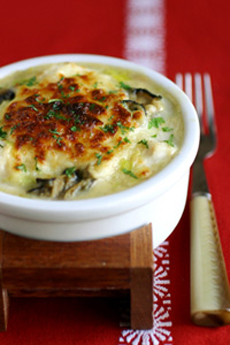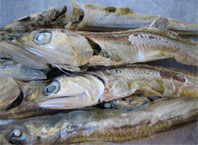

While garum died out with the Roman empire, it lives on in the West, most noticeably in the form of anchovies and anchovy paste but also in this recipe for Cod and Oyster Gratin, courtesy of the Umami Information Center.
|
KAREN HOCHMAN is Editorial Director of THE NIBBLE.
|
|
September 2006
Last Updated March 2012
|
 |
Garum: A Turning Point In Western Umami History
Page 3: From Garum To Worcestershire Sauce
This is Page 3 of a six-page article on umami foods, here focusing on the ancient Roman condiment, garum. Click on the black links below to visit other pages.
Ancient Umami
Although it was only in 1985 that the word “umami” became recognized internationally, and only in 2005 that the Fifth Taste, Cooking With Umami was published to explain it in detail to English-speakers, umami has been part of Western tradition since ancient times. Beginning in Greece and began appearing in nearly every ancient Roman recipe as early as the 7th and 8th centuries B.C.E., garum, a fermented fish sauce, was the universal condiment to flavor food—as we today use salt. There also were a lower-quality fish sauce called liquamen and a fish paste condiment called allec, made from the sediment of the garum.
Garum was a fish sauce similar to the fish sauces used in Asian cuisines, which are equally ancient (if the Roman Empire had not toppled, we’d most likely be using garum in Western cuisine today). To make garum fish, along with their intestines and salt, were mixed together and then fermented in sealed containers. Garum originally came from Greece, and the Greek words garos or garon name the fish whose intestines were originally used in the condiment’s production†. The amber-colored garum extracted first from the fermentation process was most highly prized.
|

Niboshi are small sardines that have been boiled and then dried. They are used to make a strong dashi for hearty simmered dishes. In the Roman Empire, the fresh sardines would have been fermented for garum. Photo courtesy of The Umami Information Center. |
In the 1st century B.C.E., the Roman poet Martial considered garum made from mackerel to be the finest, that made from tuna, to be of second quality, and dismisses the liquamen made from “generic” fish. By the 1st century C.E., the noted culinary writer Marcus Gavius Apicius preferred his fish sauce from mullet; but by then distinctions have vanished, and the terms garum and liquamen are interchangeable. In the cookbook attributed to him (the oldest surviving cookbook), De Re Coquinaria (“The Art of Cooking”), almost all recipes use some form of fish sauce—not surprising ingredient, as garum was used in cooking instead of salt, as well as a table condiment.
†The sauce was generally made through the crushing and fermentation in brine of the innards of various fish such as anchovies, eel, mackerel, oysters, prawns, red mullet, salmon, sardines and tuna. The garum sauce was then mixed with wine, vinegar, pepper, oil, or water and served as a condiment with a wide variety of dishes.

The ruins of a Roman garum factory in Baelo Claudia, near Tarifa, Cádiz, Spain. Spanish garum was a famous export, earning the town a measure of prestige. As popular as garum was, garum factories were unpopular: the smell given off during the fermentation of the fish sauce production was so powerful that the making of garum gradually became outlawed in densely populated areas. The process was not one of “rotting fish,” but a fermentation of enzymic proteolysis, similar to beer, vinegar, cheese, or yogurt. Photograph by Marina Amador | Wikimedia Commons.
Garum Descendants: Today’s Fish Sauces
The use of garum died out along with the Roman Empire, but fermented fish products survive in Western cuisine in the form of anchovy paste, our modern allec; and Worcestershire sauce—a fermentation of anchovies, onions, shallots, cloves, garlic, vinegar, molasses, chili peppers, soy sauce, pepper, tamarinds, corn syrup and water—which actually derived from the British occupation of India. And garum does survive in the ancient fish sauces of Asia, which appear to have a very similar method of production: Vietnamese nuoc nam, Thai nam pla and Cambodian tuk trey, Burma’s ngan-pya-yem, Korea’s jeotgal, Laos’s nam pa and Philippines’ patis and bagoong.‡ Other relatives include the Malaysian shrimp paste belachan and a similar product in Myanmar called nga-pi.
‡Garum added extra fish intestines, or might have been made wholly of fish intestines; modern fish sauces don’t add extra intestines, only those present in the fish that are fermented. For more information on garum, read this treatise from the University of Chicago.
Continue To Page 4: Umami Foods
Go To The Article Index Above

|








